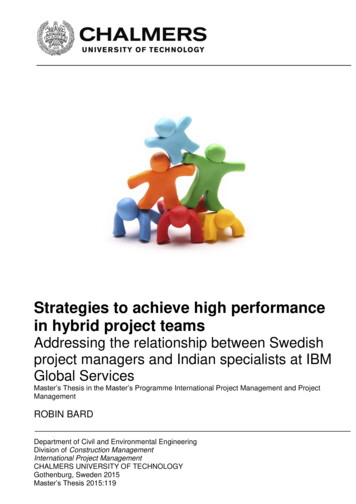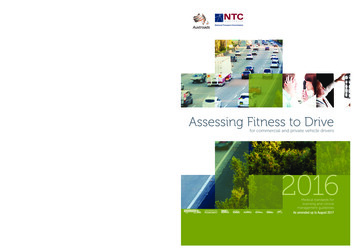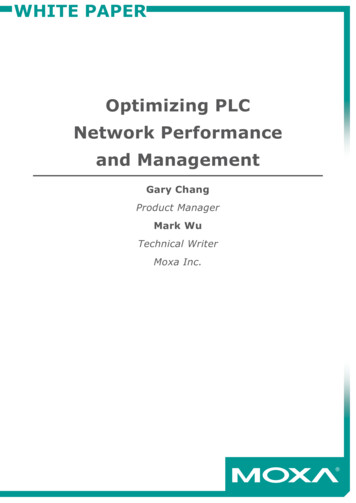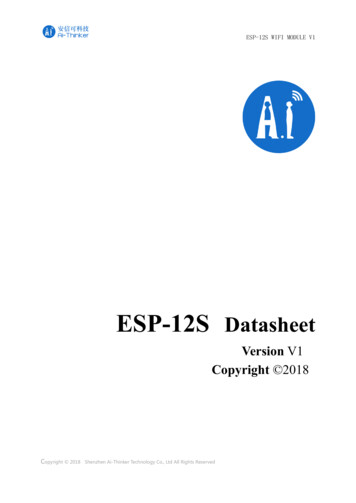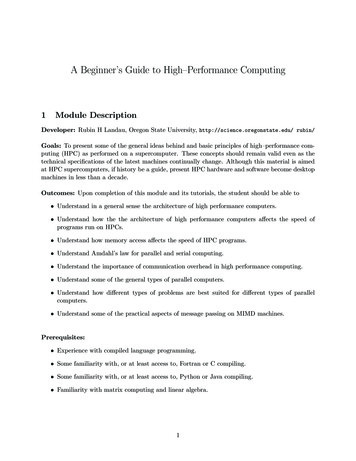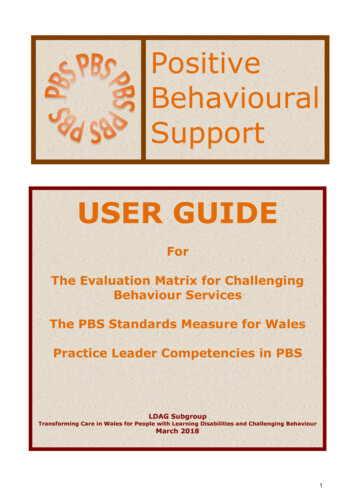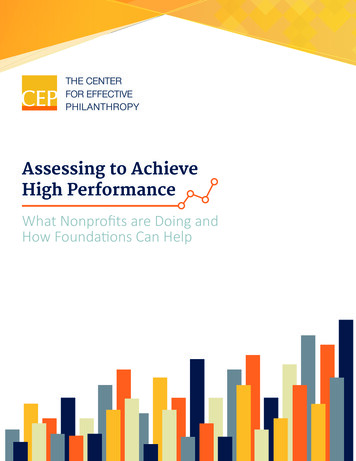
Transcription
Assessing to AchieveHigh PerformanceWhat Nonprofits are Doing andHow Foundations Can Help
AUTHORSEllie Buteau, Ph.D., Ramya Gopal, and Jennifer GlickmanFOR MORE INFORMATION, CONTACTEllie Buteau, Ph.D.Vice President – Research617-492-0800 ext. 213ellieb@effectivephilanthropy.orgABOUT THE CENTERFOR EFFECTIVE PHILANTHROPYMISSIONTo provide data and create insight so philanthropic funderscan better define, assess, and improve their effectiveness—and, as a result, their intended impact.ACKNOWLEDGMENTSWe are very appreciative of the support that made thiswork possible. Our full list of funders can be found at theback of this report.We are grateful to Paul Beaudet, John Colborn, KathleenEnright, Cynthia Gibson, Kelly Hunt, Katie Merrow, NadyaK. Shmavonian, and Nan Stone for providing feedback ona draft of the survey used for this research. We are alsograteful to Paul Carttar, Heather Clawson, Nancy Csuti,Johanna Morariu, Mario Morino, Nadya K. Shmavonian, andJehan Velji for providing feedback on an earlier draft of thisreport.This research is based on CEP’s independent data analyses,and CEP is solely responsible for its content. The reportdoes not necessarily reflect the individual views of thefunders, advisers, or others listed throughout this report.For more information on CEP, please visitwww.effectivephilanthropy.org. 2015. The Center for Effective Philanthropy, Inc.All rights reserved.
Assessing to AchieveHigh PerformanceWhat Nonprofits are Doing andHow Foundations Can HelpTable of ContentsINTRODUCTION5KEY FINDINGS7FINDING ONE9FINDING TWO11FINDING THREE13FINDING FOUR15CONCLUSION18PROFILES20APPENDIX: METHODOLOGY32
4THE CENTER FOR EFFECTIVE PHILANTHROPY
INTRODUCTIONFoundations achieve little alone — they pursuemany of their goals through the work of theirgrantees.As a result, foundations are reliant on the performance of the nonprofitsthey fund.But measuring performance is challenging, in many ways, for nonprofits.Performance for nonprofits isn’t solely determined by the net incomeline in financial statements, as it is for businesses. It is instead measuredby the progress made against tough, vexing challenges. How does anonprofit helping disadvantaged teenagers be better prepared forcollege monitor the progress of its work? What about the organizationworking to reduce harmful pollutants? Or the one focused on improvingteacher training?Measuring and improving performance is difficult work. But it’s cruciallyimportant, and there is widespread agreement among foundation andnonprofit leaders on that point.1 However, there are differing views onthe state of nonprofit performance assessment practices and on thedegree to which foundations are supporting nonprofits in those efforts.Both nonprofit and foundation leaders believe nonprofits should bedemonstrating the effectiveness of their organizations’ work.2 In a2012 survey we conducted, 80 percent of nonprofits reported usingdata to inform their efforts to improve performance on an ongoingbasis.3 However, we also saw that nonprofits were looking for moresupport from foundations in these efforts.4 While the overwhelmingmajority of foundation leaders say they provide this kind of support, theoverwhelming majority of nonprofit leaders say they aren’t receiving it.5In a 2012 survey weconducted, 80 percentof nonprofits reportedusing data to informtheir efforts to improveperformance on anongoing basis. However,we also saw thatnonprofits were lookingfor more support fromfoundations in theseefforts.For foundation leaders to most effectively support nonprofits, moreneeds to be understood about the state of practice when it comes tononprofit performance assessment. When we reported in 2012 that anoverwhelming number of nonprofits that receive foundation funding areindeed committed to performance assessment — and working to do it —we encountered some skepticism.Ellie Buteau, Mark Chaffin, and Ramya Gopal, “Transparency, Performance Assessment, and Awareness of Nonprofits’ Challenges: Are Foundationsand Nonprofits Seeing Eye to Eye?” The Foundation Review 6, no. 2 (2014): 68-69, and-Awareness-of-Nonprofits.pdf.2Ibid.3Andrea Brock, Ellie Buteau, and An-li Herring, “Room for Improvement: Foundations’ Support for Nonprofit Performance Assessment,” Center for EffectivePhilanthropy (September 2012): 4, ms/room-for-improvement/.4Ibid, 5.5Buteau, 77.1Assessing to Achieve High Performance5
There was skepticism about the type and quality of thedata nonprofits were collecting, their ability to use dataeffectively, and nonprofits’ definitions of “performanceassessment.” Since then, a number of new studies havecome out focusing on the issue of nonprofits’ use of datato understand their performance and the challengesfaced in those efforts. The findings across these pieceshave been mixed, but, overall, what is written on thisissue tends to paint nonprofits as being well-intentioned,yet lacking the capacity to collect the right data tomeasure their effectiveness.6We wanted to understand the state of practice amongnonprofits to help foundations target support where it ismost needed. This led us to pursue four questions.To tackle these questions, we turned to a panel ofU.S. nonprofit organizations typical of those receivingfoundation funding. (See Sidebar: Who Are The GranteeVoice Respondents to This Survey?) What we found isconsistent with our 2012 results in terms of nonprofits’self-reported commitment to assessing and improvingperformance.7 Nonprofits are collecting performancedata and using it to inform their improvement efforts.But our findings also raise more questions about theadequacy of the current levels of investment — and theuse of data to manage performance and share knowledgeto help other organizations improve their efforts.4 KEY QUESTIONSQUESTION ONEWhat kinds of informationare nonprofits collecting tounderstand their performance?QUESTION TWOHow, if at all, are nonprofitsinvesting in their capacity toassess their performance?QUESTION THREEIn what ways are nonprofitsusing the performanceinformation they collect?Jonathan Sotsky, “Big Interest in Big Data,” Knight Blog, The JohnS. and James L. Knight Foundation , March 26, 2014, 014/3/26/big-interest-bigdata/; Kellie C. Liket, Marta Rey-Garcia, and Karen E. H. Maas, “WhyAren’t Evaluations Working and What to Do About It: A Framework forNegotiating Meaningful Evaluation in Nonprofits,” American Journal ofEvaluation 35, no. 2 (2014): 171; Lucy Bernholz, “Let Our Data DefineUs,” Selected Readings: Making Sense of Data and Information inthe Social Sector, Markets for Good (January 2014): 33, 014/05/Markets-for-GoodSelected-Readings.pdf; Paul Carttar, Chris Lindquist, and Amy Markham,“Nonprofit Management Tools and Trends Report 2014,” The BridgespanGroup (January 2015): 4, Management-Tools-and-Trends-Report-2014.aspx; “2014 State of theNonprofit Sector Survey,” Nonprofit Finance Fund (March 2014): /2014survey natlfull results.pdf. Johanna Morariu, Katherine Athanasiades, and AnnEmery, “State of Evaluation 2012: Evaluation Practice and Capacity in theNonprofit Sector,” Innovation Network (October 2012): 12, http://www.innonet.org/client docs/innonet-state-of-evaluation-2012.pdf; LauraQuinn et al., “The Reality of Measuring Human Service Program: Resultsof a Survey,” Idealware (January 2014): 5, /IDEALWARE HSSURVEYREPORT Jan2014v4.pdf.7Brock, 4.66THE CENTER FOR EFFECTIVE PHILANTHROPYQUESTION FOURAre foundations supportingnonprofits in their efforts toassess their performance?
KEY FINDINGSKEY FINDING #1Almost all nonprofits surveyed report collecting informationto assess their performance; still, many nonprofit leaders wantto collect additional — or better — data.KEY FINDING #2The typical nonprofit in this study allocates two percent or lessof its budget to assessing its performance and few employ staffwho are dedicated to this work full time.KEY FINDING #3The nonprofits surveyed are mainly using their performanceinformation to improve their programs and services, informtheir strategic direction, and communicate about their progress;to a lesser extent, they are using it to share what they arelearning with other organizations or to manage their staff.KEY FINDING #4A minority of nonprofits in this study report receiving supportfrom foundations for their performance assessment efforts.Assessing to Achieve High Performance7
The Grantee Voice:Feedback For FoundationsThe 514 nonprofit leaders who serve on the Center for Effective Philanthropy’s The Grantee Voice panelcomplete short surveys about topics relevant to their experiences working with foundation funders. Surveys ofgrantees conducted for The Grantee Voice panel are separate and distinct from the surveys of grantees that CEPadministers for individual foundations as part of the Grantee Perception Report (GPR) process.The goals for The Grantee Voice are toCollect timely data to inform foundation practices;Gather nonprofit perspectives on working with foundations broadly;Further contribute to foundations’ knowledge of how they can workmost effectively with nonprofits.Through brief publications based on surveys from this panel, we aim tocontribute data, as well as new questions, to further important conversationsthat are happening — or need to be happening — for foundations and nonprofitsto work most productively together. Other Grantee Voice reports include Room for Improvement: Foundations’Support of Nonprofit Performance Assessment; Foundation Transparency: What Nonprofits Want; NonprofitChallenges: What Foundations Can Do; and Hearing from Those Who Matter Most: Nonprofit Practices andPerspectives in Beneficiary Feedback. These publications are available at www.effectivephilanthropy.org.Who Are The Grantee Voice Respondents to This Survey?The nonprofits on The Grantee Voice panel are representative of U.S.-based organizations with between 100,000 and 100 million in annual expenses and receive funding from foundations giving at least 5 millionannually. (See “Appendix: Methodology” for more information on how this panel was formed.)The response rate for this survey was 38 percent. The 183 nonprofit leaders (holding such titles as executivedirector, president, or CEO) who responded represent a mix of organizations that vary widely in size anddependence on foundation money, as shown in the table below. Respondents’ organizations are located acrossthe country and represent a range of program areas, including human services, the arts, health, communitydevelopment, the environment, and education.8ORGANIZATIONAL MEASURERANGEMEDIAN VALUEStaff size(in full-time equivalents, FTEs) 1 FTE to 1,400 FTEs12 FTEsAnnual expensesAbout 100,000 to 93 million 1.4 millionProportion of revenue coming fromfoundation grants 1 percent to 90 percent15 percentTHE CENTER FOR EFFECTIVE PHILANTHROPY
Finding OneKEY FINDING #1Almost all nonprofits surveyed report collectinginformation to assess their performance; still, manynonprofit leaders want to collect additional — orbetter — data.INFORMATION NONPROFITS ARECOLLECTINGWhen completing the survey, respondents were askedto keep in mind the following definition of performance:“how your organization is doing relative to the goal(s) itseeks to achieve.” Almost every organization whose CEOresponded to our survey seems to be making an effortto assess its performance. Fully 99 percent say theirorganization is collecting some information to assess itsperformance. We asked respondents to write in examplesof the types of information that they find most usefulin understanding their organization’s performance. Thethree most specific types of information respondentsprovided can be found in Figure 1. Examples ofinformation that nonprofit leaders find most useful areprovided in Figure 2.FIGURE ONE.Assessment Information Nonprofits FindMost Useful56% of nonprofitsInformation collected from programmatic assessments,or indicators of outcomes they seek to change43% of nonprofitsInformation about their organization’sreach: number of beneficiaries served orunits of service provided29% of nonprofitsFinancial information, suchas budget or fundraisingperformanceFIGURE TWO.Examples of Information that Nonprofit Leaders Find Most UsefulNonprofit’s mission/backgroundTypes of information most useful for understanding performanceEmpower girlsInformation from participantoutcome surveysPre and post specific programsurveys of girlsNumber of girls served and howthey are servedProvide employmentservices to immigrantsNumber of clients enrolled inprogramNumber of clients placed in jobsNumber of clients retaining jobsafter 12 monthsPromote responsibleforestry practicesFederal and state level forestrystatisticsStakeholder FeedbackInformation from membershipsurveysAdvance equality forLGBTQ peoplePersonal testimonials fromprogram participantsPre- and post-surveys fromprogram participantsQuantitative and demographicdata about program participantsTheatre companyInformation from audiencesurveysSales trendsArtist retentionHumane treatmentof animalsStatistics on program use/goalsFinancial analysisCustomer satisfaction surveyAdvocacyorganizationLegislation passedPolicies adaptedMedia coverage of issuesAssessing to Achieve High Performance9
WHAT NONPROFITS WOULD LIKE TO DODIFFERENTLYHalf of nonprofit leaders who responded to an openended question about what they’d like to do to betterassess and/or improve their performance, say they wantto acquire additional, or better, data.8 Among this group: 71 percent cite a desire for more detailed data,a larger volume of data, or more frequentlycollected data. One nonprofit leader notes,“If we could collect disaggregated data on ourclients as well as communities that we want toserve, it would help us have a clearer pictureof the kinds of issues that they face and whatprograms to prioritize.” Another nonprofitleader is seeking “access to more data fromthe [city’s] department of education to help usmore fully assess the impact of our programs onchildren.”40 percent say they want better data tounderstand their organization’s performance.One nonprofit leader wants “to know moreabout impact on community and measurabilityof attitudinal changes among the people in thecommunity. For example, are we creating a morehumane community?” Another nonprofit leaderis seeking, “better metrics of organizationalchange (for organizations we seek to influence)and public perception.”Almost one-third say that they would like morestaff resources, greater staff expertise, or the abilityto hire third-party evaluators to better assess ormanage their organization’s performance.9 “Withgreater staff and financial resources, it would behelpful to understand better which specific strategiesand tactics are most effective,” says one respondent.Another says, “We have such an incredible wealth ofinformation — we would love to have a statisticiandevoted to running ongoing trend analysis, learningmore about what we do well and what we don’t.”What Drives Nonprofits toAssess Their Performance?The most important reason for assessing theirperformance, cited by 76 percent of nonprofit leaders,is to learn and improve. External accountability — tofunders and stakeholders — and communicating publiclyabout performance were the next most common reasons.Reasons related to internal accountability — of staff andto the board — were cited by few nonprofit leaders.FIGURE THREE.Nonprofits’ Primary Reasons for AssessingPerformanceWhat are the two most important reasons your organizationassesses its performance?Learn to improve from work76%Fulfill funder requirements40%Communicate externally about performance37%Accountability to stakeholders33%Accountability of staff to performance9%Fulfill board requirements3%Percentage of nonprofitsThis question was asked as an open-ended item in the survey and 75percent of respondents provided a response.9This statistic is out of the 75 percent of respondents who answered theopen-ended item about what they would like to do to better assess and/or manage their performance.810THE CENTER FOR EFFECTIVE PHILANTHROPY
Finding TwoKEY FINDING #2The typical nonprofit in this study allocatestwo percent or less of its budget to assessingits performance and few employ staff who arededicated to this work full time.Although almost 90 percent of nonprofit leaders reportthat their organization allocates some portion of itsbudget towards performance assessment efforts, thetypical allocation seems small relative to the complexity ofthis work. (See Figure 4.) About half of nonprofits spendtwo percent or less of their budget on efforts to assessperformance.About half ofnonprofits spendtwo percent or lessof their budget onefforts to assessperformance.Percentage of nonprofitsFIGURE FOUR.Nonprofits’ Allocation of Budget for Performance Assessment33%11%0%27%18%11%Less than 1%1% to 2%3% to 5%6% or morePercentage of budget spent on assessmentAssessing to Achieve High Performance11
Just one-fifth of nonprofits employ one or more full-timestaff members dedicated to helping them assess theirperformance. (See Figure 5.) Nonprofits that employassessment staff are more likely to be in the top quartileof our sample for annual expenses — 4MM or more.Of nonprofits in the top expense quartile, 44 percentemploy staff dedicated to assessment compared to 12percent of smaller nonprofits.Almost one-third of nonprofits in this study use thirdparty evaluators to conduct formal assessments of theirperformance. Nonprofits that use third-party evaluatorsare more likely to have annual expenses greater than 1.4MM, the median annual expense value amongorganizations in this study; 44 percent of nonprofits withgreater than typical annual expenses use third-partyevaluators compared to 18 percent of smaller nonprofits.DIGGING DEEPERDo Performance Assessment PracticesDiffer by Size of Nonprofit Organizations?For the most part, nonprofits’ performance assessmentpractices do not differ by size of the nonprofit, asmeasured by annual expenses. Even the proportion ofbudget that nonprofits in this study report spending onperformance assessment does not vary by organizationsize. Two differences that do emerge are that largernonprofits are more likely to:Employ staff dedicated to working on assessing theorganization’s performance.Use third parties to help with this work.FIGURE FIVE.Nonprofits’ Staffing for PerformanceAssessmentPercentage of nonprofits60%Neither use third-party evaluators nor employ anyfull-time staffDifferences by Nonprofits’ Allocation ofResources for AssessmentOur data suggests that there are some key differencesbetween nonprofits that spend more than two percentof their budget on assessment (the median valueamong organizations in this study), and those thatspend two percent or less. Those that spend above themedian tend to:Use the results of their performance assessmentsmore in general;Use the results of their performance assessments toa greater extent to inform their strategic direction;Have more discussion about assessment with theirfoundation funders;Receive more than 15 percent of their revenue (themedian value in this study) from foundation grants.11%Use third-partyevaluators and employone or more full-timestaff members20%Only use third-partyevaluatorsIn addition, nonprofits that spend more than fivepercent of their budget on assessment use the resultsof their performance information more than nonprofitsthat spend one percent or less for:Identifying development opportunities for staff;9%Only employ one ormore full-time staffmembers12THE CENTER FOR EFFECTIVE PHILANTHROPYRecognizing strong staff performance;Changing allocation of resources acrossprograms and services.
The nonprofits surveyed are mainly using theirperformance information to improve their programsand services, inform their strategic direction, andcommunicate about their progress; to a lesserextent, they are using it to share what they arelearning with other organizations or to manage theirstaff.Finding ThreeKEY FINDING #3PERFORMANCE INFORMATION FORPROGRAMS AND STRATEGIESMore than 80 percentof nonprofits reportthat they are usingtheir performanceinformation to improvetheir programs andservices at least “to agreat extent.”More than 80 percent of nonprofits report that they areusing their performance information to improve theirprograms and services at least “to a great extent,” and68 percent are using their information to inform theirstrategic direction at least “to a great extent.”10 (SeeFigure 6.)Nonprofits are using their assessment information moreto improve their programs and services than they are tomake decisions about adding or eliminating programsand services, or to change resources across programsand services.FIGURE SIX.Nonprofits’ Use of Performance Information for Programs and StrategiesPercentage of nonprofits that use results of performance assessments to a great or very great extent to:Make improvements to programs/services83%Inform the organization’s strategic direction68%Make decisions about adding or eliminating programs/services61%Change resources across programs/services46%Includes nonprofit leaders who rated a 4 or 5 on a 1-5 scale where 1 Not at all, 2 A little extent, 3 Some extent, 4 A great extent, and 5 A very greatextent.10Assessing to Achieve High Performance13
PERFORMANCE INFORMATION FORCOMMUNICATING ABOUT PROGRESSNonprofits are using the results of their performanceassessments to communicate about their progress: about70 percent are using their performance information toattract or maintain donors, or to publicly communicatetheir impact. While nonprofits are using performancedata, our survey data raises questions about whetherthey are sharing what they are learning as widely as theycould be. Only 41 percent of nonprofits say they areusing their performance information to share what theyhave learned with other organizations at least “to a greatextent.”11 (See Figure 7.)PERFORMANCE INFORMATION FORMANAGING STAFFNonprofits are using their performance information to theleast extent for managing their staff: informing decisionsabout staffing levels, recognizing staff performance, oridentifying development opportunities for them.12 (SeeFigure 8.) The nonprofits in our sample with the smalleststaff sizes — those with four full-time employees orfewer — tend to use their performance information toa lesser extent to inform decisions about staffing levelsor to recognize strong staff performance than nonprofitswith larger staff sizes.Our data suggests areas of opportunity not just fornonprofits to collect more and richer data, but also to useit more broadly — with other organizations and internally— to improve practice.FIGURE SEVEN.Nonprofits’ Use of PerformanceInformation to CommunicatePercentage of nonprofits that use results of performanceassessments to a great or very great extent to:Attract new donors or maintain existing ones71%Communicate publicly what the organization has achieved70%Share what it has learned about what works, or does notwork, with other organizations41%FIGURE EIGHT.Nonprofits’ Use of PerformanceInformation for Managing StaffPercentage of nonprofits that use results of performanceassessments to a great or very great extent to:Inform decisions about staffing levels40%Recognize strong staff performance38%Identify development opportunities for staff36%Only 41 percent ofnonprofits say they areusing their performanceinformation to share whatthey have learned withother organizations at least“to a great extent.”Includes nonprofit leaders who rated a 4 or 5 on a 1-5 scale where1 Not at all, 2 A little extent, 3 Some extent, 4 A great extent, and5 A very great extent. Innovation Network has found that 48 percent ofnonprofits use their evaluation findings to share best practices/lessonslearned. Morariu, “State of Evaluation,” 15, http://www.innonet.org/client es nonprofit leaders who rated a 4 or 5 on a 1-5 scale where1 Not at all, 2 A little extent, 3 Some extent, 4 A great extent, and5 A very great extent.1114THE CENTER FOR EFFECTIVE PHILANTHROPY
Finding FourKEY FINDING #4A minority of nonprofits in this study reportreceiving support from foundation funders for theirperformance assessment efforts.Just one-third of nonprofit leaders in this study saythat their foundation funders tend to support theirorganization — through financial or non-monetaryassistance — to help it assess its performance. 13(See Figure 9.)It’s not just financial support that is often missing. Thereis still not much discussion occurring about assessment:only 39 percent of nonprofit leaders in this study reporthaving at least a moderate amount of discussion withfoundations about assessment.14 (See Figure 10.)FIGURE NINE.Foundation Support for NonprofitPerformance AssessmentFIGURE TEN.Amount of Discussion Between Foundationsand Nonprofits on Performance AssessmentPercentage of nonprofits36%Percentage of nonprofit leadersHow much discussion tends to take place between you and yourfoundation funders on matters related to performance assessment?Tend to receive financial and/ornon-monetary support64%Do not tend to receive anysupport39%Moderateor morediscussion24%Somediscussion37%A little or lessdiscussionIn 2012, we found that 29 percent of nonprofits were receiving foundation support for their assessment efforts. Brock, 6.Includes respondents who rated a 5, 6, or 7 on a 1-7 scale, where 1 No discussion, 2 Very little discussion, 3 A little discussion, 4 Somediscussion, 5 Moderate discussion, 6 Considerable discussion, and 7 A lot of discussion.1314Assessing to Achieve High Performance15
A similar proportion of nonprofit leaders say they tendto have little to no discussion. This matters because ouranalysis reveals that when nonprofit leaders have morediscussion with foundations on issues about performanceassessment:They find foundations to be more helpful to theirorganization’s ability to assess its progress;They use their organization’s performanceinformation to a greater extent.The amount of discussion that takes place is correlatedwith nonprofits’ dependency on foundation money.Nonprofit leaders whose organizations receive above themedian proportion of revenue from foundation grants inthis study — 15 percent — tend to have more discussionwith foundations about assessment. But even amongthose whose organizations have a higher proportion ofrevenue coming from foundation grants, only about halfreport having at least a moderate amount of discussionwith foundations about assessment.Data Requirements:Nuisance or a Help?Almost all nonprofit leaders report that their foundationfunders require them to report data about theirorganization’s performance.16 A majority say they findthese requirements to be at least moderately useful totheir organization’s ability to assess its performance.17(See Figure 11.)FIGURE ELEVEN.Utility of Foundations’ Performance DataRequirementsPercentage of nonprofit leadersHow useful do your foundation funders’ data requirements tend tobe to your organization’s ability to assess its performance?DIGGING DEEPERWhat Should Foundations Be Discussingwith Nonprofits about PerformanceAssessment?In our 2012 research, we found that 71 percent ofnonprofit leaders wanted to have more discussionabout how to develop the skills of their staff tocollect and interpret performance data.15 In addition,58 percent said they were seeking more discussionabout how to interpret the data they collected andwhat they were learning about their performance.Brock, 8.Specifically, 97 percent of nonprofit leaders say that more thanone of their foundation funders require them to report data on theirorganization’s performance.17Includes respondents who rated a 5, 6, or 7 on a 1-7 scale, where1 Not at all useful, 2 Not very useful, 3 A little useful, 4 Somewhatuseful, 5 Moderately useful, 6 Very useful, and 7 Extremely useful.151616THE CENTER FOR EFFECTIVE PHILANTHROPY58%Moderately ormore useful17%Somewhatuseful25%A little or lessusefulThe utility of foundations’ data requirements matter —when nonprofit leaders find them to be more useful, theytend to find their foundation funders more helpful totheir organization’s ability to assess its performance.Among nonprofit leaders who find funders’ requirementsto be useful, half say the utility comes from the alignmentbetween the requirements and their organizations’ goalsor the goals of the work being funded. One nonprofitleader says, “The funders’ requirements help us to takea closer look at how we are doing in meeting our client’sneeds.” Another says that the requirements are usefulwhen funders “request specific outcome measures tied tothe grant proposal [and are] reported on a predeterminedtime table.”
Finding FourWhat Foundations Can Do:Learning from Helpful Funders[The foundation] spenta considerable amountof time in helping usthink through bestmethods for assessingperformance and thenallocated funds inthe budget for us tosuccessfully carryout theassessment.Almost two-thirds of nonprofit leadersin this study could name at least onefoundation that had been helpful totheir organization’s efforts to assess itsperformance.Below are some examples of what those foundations did:“Our program officers are so well informed and engagedas a partner with regard to the project with time forindividual guidance and funding for the efforts. Theirbreadth of experience in similar situations and willingnessto share lessons learned by others, as well as to makeconnections to others, has been invaluabl
AUTHORS Ellie Buteau, Ph.D., Ramya Gopal, and Jennifer Glickman FOR MORE INFORMATION, CONTACT Ellie Buteau, Ph.D. Vice President - Research 617-492-0800 ext. 213
